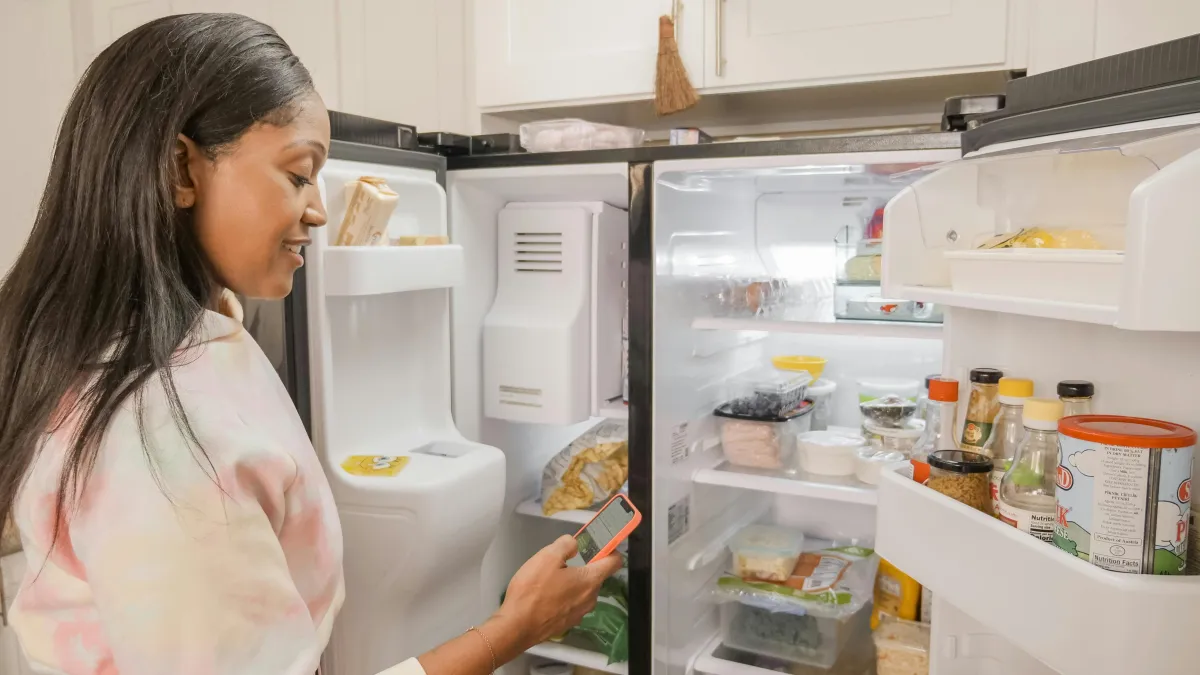
When ADHD Makes You Hungry: Foods That Feed Focus
I once found my phone in the fridge....
Not balanced neatly on a shelf, but wedged beside a jar of peanut butter like it had gone in there to cool off. That moment told me two things. One, I clearly spend a lot of time around the fridge. Two, I wasn’t hungry as much as I was chasing dopamine.
If you have an ADHD brain, you probably understand the impulsive fridge raid. You go in for a snack and come out twenty minutes later with crumbs, regret, and a vague sense of confusion. A lot of times, it’s not even about food. It’s about stimulation. Our taste buds become our fidget toys.
I used to think I just had bad eating habits. Now I know it was part of living with a neurodevelopmental disorder that affects attention, impulse control, and reward processing. That’s the thing about Attention Deficit Hyperactivity Disorder, it doesn’t just make it hard to start tasks or manage time. It also affects how we interpret hunger cues, how we make food decisions, and how we regulate energy.
For me, learning about nutrition was a vital point in managing ADHD symptoms at work. Not because I suddenly became some kind of meal planning guru, but because I realised how much food impacts brain function, focus, and mood....SPOILER... still not perfect and don't ever intend to be.
Why ADHD and Food Are So Linked
The hallmark of ADHD is difficulty with executive function, planning, organising, and following through. When you combine that with low dopamine, you get a perfect storm for impulsive eating. The brain wants quick comfort food to fill that chemical gap, not an elaborate meal that takes an hour to cook.
When I was in my corporate job, I lived on caffeine, bread, and vending machine snacks. They gave me energy for a moment, then I’d crash. The impact of ADHD on my blood sugar regulation was clear, the peaks and dips matched my productivity levels almost perfectly.
It’s not just about sugar. Research shows that people with ADHD often have deficiencies in key nutrients like iron, zinc, magnesium, and omega-3 fatty acids. These are crucial for dopamine production and nervous system health. Without enough omega-3 from foods like fish oil, flaxseed, or lean meats, the brain struggles to regulate mood and focus.
A lot of ADHD adults are also low in B vitamins, which support metabolism and energy. When you’re deficient, you can feel like you’ve got permanent low energy or brain fog. Add stimulant medications into the mix, which can suppress appetite, and you’ve got another reason why consistent meals become a real challenge.
You’re Not Lazy, You’re Under fuelled

The good news is that none of this is about willpower. It’s about biology. The ADHD brain burns through glucose faster and has more difficulty recognising the body’s signals of physical hunger. You might not realise you’re starving until you’re already in the kitchen tearing open frozen foods.
If you live with ADHD, you’ve probably noticed patterns: skipping breakfast foods because mornings are chaos, forgetting lunch because of hyperfocus, then binge eating in the evening when the executive dysfunction finally relaxes. This isn’t lack of discipline, it’s a rhythm problem.
One of the most effective strategies I’ve found is to set up consistent meals rather than relying on willpower. I will prepare simple, balanced meals that include protein, whole grains, and healthy fats, not every week but on the ones I know are going to be hard I like to have a few things I can just throw down me without a thought process. I don’t chase the perfect meal, just a full meal that keeps me stable.
When I coach clients, I always say the best way to support your focus is through non pressurised structure. Not just with your calendar, but with your food.
My ADHD Food Experiments
I started experimenting with food years ago. Not in a diet culture kind of way, more like a frustrated scientist trying to understand why my brain kept crashing halfway through the day.
I tracked how different foods affected my focus and mood. A quick bowl of cereal left me foggy by 10 a.m., while eggs and oats gave me steady energy. Then I stumbled on something strange:figs and crunchy apples.
They became my favourite foods for focus. Figs satisfied my sweet tooth without the crash, and the crunch of apples gave that sensory feedback my ADHD brain loves. It turns out, the sound and texture of crunchy foods stimulate the brain just enough to release dopamine. It’s the same reason we enjoy crisps or carrots, the sensory input calms that restless itch.
So now, when I’m writing or coaching, I keep fresh fruit nearby. It’s mindful eating that still feeds the dopamine need. My shopping list always includes apples, figs, yoghurt, nuts, and a few easy meals I can grab without decision fatigue.
There are weeks that this stuff doesn't get eaten because we are not perfect...but if those weeks happen I promise you I feel the difference and that alone brings me back to my delicious seedy figs.
When You’re Hungry, You’re Probably Bored
A lot of ADHD eating patterns aren’t about hunger at all. They’re about stimulation. We mistake boredom or emotional flatness for hunger because both trigger the same urge, to feel something.
When I catch myself standing in front of the fridge again, I ask, “What do I actually need right now?” Sometimes it’s movement, not food. Sometimes I need water, or novelty, or a quick stretch to reset my executive function.
It’s a simple step, but it helps interrupt emotional eating before it takes over. If I am genuinely hungry, I’ll aim for something nourishing rather than grabbing the first unhealthy foods I see.
Next time you catch yourself fridge-gazing, pause and check your body’s signals. Are you tired, stressed, or overstimulated? ADHD makes it easy to confuse these sensations. The best way to manage them is through awareness, not judgment.
The Nutrient Piece: Why Deficiency Hits Hard

There’s a growing body of research connecting ADHD to nutrient deficiencies. Iron and zinc support dopamine and norepinephrine production. Magnesium helps regulate the nervous system and prevent sensory overload. Omega-3 fatty acids improve attention and working memory.
When you’re low on these, even the most basic ADHD tasks, time management, decision-making, staying on one thing, become harder. The body and brain are literally under-resourced.
I now take a mineral supplement with zinc and magnesium, eat oily fish or flaxseed for omega-3, and include whole grains and leafy greens for B vitamins. It’s not glamorous, but it works.
The aim isn’t perfection. It’s giving your brain the raw materials it needs to do its job. When those levels are balanced, focus feels less like a fight.
The Role of Executive Function in Eating
One of the biggest challenges with ADHD and eating habits is executive dysfunction. Even if you want to eat well, meal prep can feel impossible. You stand in the grocery store staring at food options until your brain short-circuits and you grab whatever’s easiest.
I used to overbuy elaborate meal ingredients, then forget them until they went off. These days, I keep things simple. I plan for easy meals that I can make even when I’m tired or distracted, pasta with lean meats, whole fruits, frozen vegetables, or a quick smoothie.
A consistent grocery shopping routine helps too. I go at the same time each week with a clear grocery list. It removes decision fatigue and reduces the chance of wandering into the snack aisle for “research purposes.”
You don’t need to cook like a chef. You just need a few dependable meal plans that you can fall back on. Think of it as building a system for your dietary habits the same way you’d build one for work.
Food, Focus, and Work Performance
When I started eating with more structure, my work performance changed dramatically. My brain stopped yo-yoing between hyperfocus and burnout. I could sit in meetings without zoning out or reaching for caffeine to survive.
Healthy eating habits gave me more than energy, they gave me predictability. My mood stabilised, my impulsivity dropped, and I didn’t spend every afternoon fighting sleep. For someone with ADHD, that stability is priceless.
If you work long hours or juggle deadlines, treat your brain like it’s your most valuable tool. Because it is. A balanced diet with complex carbohydrates, healthy fats, and enough protein is the best insurance policy you can give yourself.
When Eating Becomes Emotional

For some of us, food isn’t just fuel. It’s comfort, distraction, or even a coping mechanism for ADHD struggles. Emotional eating, binge eating, or Avoidant Restrictive Food Intake Disorder can all appear alongside ADHD. These are mental health issues, not moral failings.
If you suspect your eating patterns are causing distress or tie into body image or weight loss pressures, a clinical psychologist or registered dietitian can help. There’s no shame in seeking support. ADHD adds layers of complexity to food relationships that diet culture rarely accounts for.
Remember, this isn’t about being a picky eater or chasing a vegan diet to fix ADHD. It’s about understanding how food interacts with your energy, focus, and emotional balance.
Practical Ways to Support Your ADHD Brain
Here are some simple steps that help me and my clients manage food and focus more effectively:
1. Start the day right
Breakfast foods that include protein, like eggs or yoghurt, help regulate blood sugar. Skipping breakfast is a fast track to brain fog.
2. Pair carbs with fats or protein
Complex carbohydrates and healthy fats (like avocado, nuts, or olive oil) slow energy release and keep you full longer.
3. Schedule your meals
Treat eating as part of your time management system, not an optional extra. Set alarms or reminders if needed.
4. Keep quick options nearby
Peanut butter, fresh fruit, and whole grains make a great emergency meal when executive function runs low.
5. Stay curious
Research recipes that excite you. ADHD thrives on novelty, so rotate your meal plans every few weeks to avoid boredom.
6. Watch for caffeine and artificial sweeteners
They can trigger crashes and affect sleep, especially if combined with stimulant medications.
Experiment, Don’t Judge
Think of your relationship with food as a lifelong experiment. Try intuitive eating, where you listen to your body’s signals rather than food rules. Track what helps your focus and what drags you down.
There’s no one-size-fits-all ADHD diet. The best way to figure it out is through self-awareness and trial and error. Some days you’ll eat beautifully balanced meals. Other days, you’ll eat toast for dinner. Both are fine. The goal isn’t perfection, it’s progress.
Final Thought
These days, I still find myself standing at the fridge sometimes, but I recognise what’s happening. My brain wants stimulation, not snacks. Sometimes I take a deep breath, grab a crunchy apple, and smile at the memory of my phone chilling next to the butter.
ADHD makes food tricky, but it’s also an opportunity. Once you understand how your dietary habits shape your focus and energy, you can build systems that make life easier. Feed your brain well, and it’ll reward you with clarity, stability, and maybe even fewer fridge-related surprises.
If You’re Ready to Learn More
If this resonated, there are a few ways I can help:
Take my free ADHD Insight Report to discover your unique ADHD patterns and personalised strategies for focus and energy.
Work with me 1-to-1 if you’re ready to build systems that actually suit your brain.
Or join the ADHD Reset System™, a 3-month process that helps you rebuild focus, energy, and calm, starting with your foundations, including food, rest, and emotional regulation.
You deserve to function at your best without burning out. And I promise, you’re not the only one who’s ever found their phone in the fridge.

